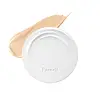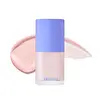What's inside
What's inside
 Key Ingredients
Key Ingredients

 Benefits
Benefits

 Concerns
Concerns

 Ingredients Side-by-side
Ingredients Side-by-side

Centella Asiatica Extract
CleansingCI 77891
Cosmetic ColorantPhenyl Trimethicone
Skin ConditioningDimethicone
EmollientMethyl Trimethicone
Skin ConditioningPropanediol
SolventDiisostearyl Malate
EmollientGlycerin
HumectantTridecyl Trimellitate
EmollientLauryl Polyglyceryl-3 Polydimethylsiloxyethyl Dimethicone
Skin ConditioningCaprylyl Methicone
Skin ConditioningTrimethylsiloxysilicate
EmollientMica
Cosmetic Colorant1,2-Hexanediol
Skin ConditioningHoney Extract
HumectantRosmarinus Officinalis Leaf Oil
MaskingLeptospermum Scoparium Leaf Extract
Skin ConditioningPolyglyceryl-4 Isostearate
EmulsifyingMagnesium Sulfate
Water
Skin ConditioningDisteardimonium Hectorite
StabilisingGlyceryl Caprylate
EmollientButylene Glycol
HumectantStearic Acid
CleansingAluminum Hydroxide
EmollientAlumina
AbrasiveTriethoxycaprylylsilane
Lactobacillus
Skin ConditioningAcrylates/Dimethicone Copolymer
Skin ConditioningTrisodium Ethylenediamine Disuccinate
Ceramide NP
Skin ConditioningMadecassoside
AntioxidantPhytosphingosine
Skin ConditioningTocopherol
AntioxidantCI 77492
Cosmetic ColorantCI 77491
Cosmetic ColorantCI 77499
Cosmetic ColorantCentella Asiatica Extract, CI 77891, Phenyl Trimethicone, Dimethicone, Methyl Trimethicone, Propanediol, Diisostearyl Malate, Glycerin, Tridecyl Trimellitate, Lauryl Polyglyceryl-3 Polydimethylsiloxyethyl Dimethicone, Caprylyl Methicone, Trimethylsiloxysilicate, Mica, 1,2-Hexanediol, Honey Extract, Rosmarinus Officinalis Leaf Oil, Leptospermum Scoparium Leaf Extract, Polyglyceryl-4 Isostearate, Magnesium Sulfate, Water, Disteardimonium Hectorite, Glyceryl Caprylate, Butylene Glycol, Stearic Acid, Aluminum Hydroxide, Alumina, Triethoxycaprylylsilane, Lactobacillus, Acrylates/Dimethicone Copolymer, Trisodium Ethylenediamine Disuccinate, Ceramide NP, Madecassoside, Phytosphingosine, Tocopherol, CI 77492, CI 77491, CI 77499
Water
Skin ConditioningDibutyl Adipate
EmollientCI 77891
Cosmetic ColorantDipropylene Glycol
HumectantC12-15 Alkyl Benzoate
AntimicrobialCoco-Caprylate/Caprate
EmollientIsononyl Isononanoate
EmollientDiethylamino Hydroxybenzoyl Hexyl Benzoate
UV FilterPhenethyl Benzoate
EmollientGlycerin
HumectantSodium Hyaluronate
HumectantOpuntia Coccinellifera Fruit Extract
Skin ConditioningChitosan
Hydrolyzed Hyaluronic Acid
HumectantHyaluronic Acid
HumectantBis-Ethylhexyloxyphenol Methoxyphenyl Triazine
Skin ConditioningEthylhexyl Triazone
UV AbsorberPolysilicone-15
UV FilterTerephthalylidene Dicamphor Sulfonic Acid
UV AbsorberPropanediol
SolventPentylene Glycol
Skin Conditioning1,2-Hexanediol
Skin ConditioningPolyhydroxystearic Acid
EmulsifyingPoly C10-30 Alkyl Acrylate
Emulsion StabilisingPolyglyceryl-3 Methylglucose Distearate
EmulsifyingBisabolol
MaskingPotassium Cetyl Phosphate
EmulsifyingTromethamine
BufferingAluminum Hydroxide
EmollientHydroxyethyl Urea
HumectantSodium Polyacryloyldimethyl Taurate
Emulsion StabilisingHydroxyacetophenone
AntioxidantPanthenol
Skin ConditioningStearic Acid
CleansingIsododecane
EmollientOctyldodecanol
EmollientHydroxyethyl Acrylate/Sodium Acryloyldimethyl Taurate Copolymer
Emulsion StabilisingSorbitan Isostearate
EmulsifyingPolyglyceryl-4 Isostearate
EmulsifyingPolyglyceryl-2 Dipolyhydroxystearate
Skin ConditioningHydroxypropyl Methylcellulose Stearoxy Ether
Polyacrylate Crosspolymer-6
Emulsion StabilisingIsopropyl Titanium Triisostearate
EmollientAdenosine
Skin ConditioningBiosaccharide Gum-1
HumectantSodium Lauroyl Glutamate
Acetyl Glucosamine
Skin ConditioningLysine
Skin ConditioningMagnesium Chloride
Sodium Hyaluronate Crosspolymer
HumectantCaprylyl Glycol
EmollientButylene Glycol
HumectantHydrogenated Lecithin
EmulsifyingBenzyl Glycol
SolventHydrolyzed Glycosaminoglycans
HumectantCholesterol
EmollientHydroxypropyltrimonium Hyaluronate
Ethylhexylglycerin
Skin ConditioningCeramide NP
Skin ConditioningSodium Acetylated Hyaluronate
HumectantHydrolyzed Sodium Hyaluronate
Skin ConditioningPotassium Hyaluronate
Skin ConditioningBehenyl Alcohol
EmollientDisodium EDTA
Xanthan Gum
EmulsifyingParfum
MaskingAlpha-Isomethyl Ionone
PerfumingLinalool
PerfumingCI 77491
Cosmetic ColorantWater, Dibutyl Adipate, CI 77891, Dipropylene Glycol, C12-15 Alkyl Benzoate, Coco-Caprylate/Caprate, Isononyl Isononanoate, Diethylamino Hydroxybenzoyl Hexyl Benzoate, Phenethyl Benzoate, Glycerin, Sodium Hyaluronate, Opuntia Coccinellifera Fruit Extract, Chitosan, Hydrolyzed Hyaluronic Acid, Hyaluronic Acid, Bis-Ethylhexyloxyphenol Methoxyphenyl Triazine, Ethylhexyl Triazone, Polysilicone-15, Terephthalylidene Dicamphor Sulfonic Acid, Propanediol, Pentylene Glycol, 1,2-Hexanediol, Polyhydroxystearic Acid, Poly C10-30 Alkyl Acrylate, Polyglyceryl-3 Methylglucose Distearate, Bisabolol, Potassium Cetyl Phosphate, Tromethamine, Aluminum Hydroxide, Hydroxyethyl Urea, Sodium Polyacryloyldimethyl Taurate, Hydroxyacetophenone, Panthenol, Stearic Acid, Isododecane, Octyldodecanol, Hydroxyethyl Acrylate/Sodium Acryloyldimethyl Taurate Copolymer, Sorbitan Isostearate, Polyglyceryl-4 Isostearate, Polyglyceryl-2 Dipolyhydroxystearate, Hydroxypropyl Methylcellulose Stearoxy Ether, Polyacrylate Crosspolymer-6, Isopropyl Titanium Triisostearate, Adenosine, Biosaccharide Gum-1, Sodium Lauroyl Glutamate, Acetyl Glucosamine, Lysine, Magnesium Chloride, Sodium Hyaluronate Crosspolymer, Caprylyl Glycol, Butylene Glycol, Hydrogenated Lecithin, Benzyl Glycol, Hydrolyzed Glycosaminoglycans, Cholesterol, Hydroxypropyltrimonium Hyaluronate, Ethylhexylglycerin, Ceramide NP, Sodium Acetylated Hyaluronate, Hydrolyzed Sodium Hyaluronate, Potassium Hyaluronate, Behenyl Alcohol, Disodium EDTA, Xanthan Gum, Parfum, Alpha-Isomethyl Ionone, Linalool, CI 77491
 Reviews
Reviews

Ingredients Explained
These ingredients are found in both products.
Ingredients higher up in an ingredient list are typically present in a larger amount.
1,2-Hexanediol is a synthetic liquid and another multi-functional powerhouse.
It is a:
- Humectant, drawing moisture into the skin
- Emollient, helping to soften skin
- Solvent, dispersing and stabilizing formulas
- Preservative booster, enhancing the antimicrobial activity of other preservatives
Aluminum Hydroxide is a form of aluminum. It can be naturally found in nature as the mineral gibbsite. In cosmetics, Aluminum Hydroxide is used as a colorant, pH adjuster, and absorbent.
As a colorant, Aluminum Hydroxide may add opacity, or reduce the transparency. Aluminum hydroxide is contains both basic and acidic properties.
According to manufacturers, this ingredient is an emollient and humectant. This means it helps hydrate the skin.
In medicine, this ingredient is used to help relieve heartburn and help heal ulcers.
There is currently no credible scientific evidence linking aluminum hydroxide in cosmetics to increased cancer risk.
Major health organizations allow the use of aluminum hydroxide in personal care products and have not flagged it as a carcinogenic risk at typical usage levels.
Learn more about Aluminum HydroxideButylene Glycol (or BG) is used within cosmetic products for a few different reasons:
Overall, Butylene Glycol is a safe and well-rounded ingredient that works well with other ingredients.
Though this ingredient works well with most skin types, some people with sensitive skin may experience a reaction such as allergic rashes, closed comedones, or itchiness.
Learn more about Butylene GlycolCeramide NP is a type of ceramide and formally known as ceramide 3.
Ceramides are intercellular lipids naturally found in our skin that bonds dead skin cells together to create a barrier. They are known for their ability to hold water and thus are a great ingredient for dry skin.
Ceramides are an important building block for our skin barrier. A stronger barrier helps the skin look more firm and hydrated. By bolstering the skin ceramides act as a barrier against irritating ingredients. This can help with inflammation as well.
If you would like to eat ceramides, sweet potatoes contain a small amount.
Read more about other common types of ceramides here:
Ceramide AP
Ceramide EOP
Ci 77491 is also hydrated iron III oxide. It's sole purpose is to give a red/pink hue to products.
Iron III oxides are classified as inorganic chemicals for coloring.
Synthetically created Ci 77491 is considered safer than those naturally found. This is because the synthetically created version may contain less impurities. Iron oxides are generally non-toxic and non-allergenic.
Learn more about CI 77491Ci 77891 is a white pigment from Titanium dioxide. It is naturally found in minerals such as rutile and ilmenite.
It's main function is to add a white color to cosmetics. It can also be mixed with other colors to create different shades.
Ci 77891 is commonly found in sunscreens due to its ability to block UV rays.
Learn more about CI 77891Glycerin is already naturally found in your skin. It helps moisturize and protect your skin.
A study from 2016 found glycerin to be more effective as a humectant than AHAs and hyaluronic acid.
As a humectant, it helps the skin stay hydrated by pulling moisture to your skin. The low molecular weight of glycerin allows it to pull moisture into the deeper layers of your skin.
Hydrated skin improves your skin barrier; Your skin barrier helps protect against irritants and bacteria.
Glycerin has also been found to have antimicrobial and antiviral properties. Due to these properties, glycerin is often used in wound and burn treatments.
In cosmetics, glycerin is usually derived from plants such as soybean or palm. However, it can also be sourced from animals, such as tallow or animal fat.
This ingredient is organic, colorless, odorless, and non-toxic.
Glycerin is the name for this ingredient in American English. British English uses Glycerol/Glycerine.
Learn more about GlycerinThis ingredient is an emulsifer and stabilizer. It comes from isostearic acid and polyglycerin.
As an emulsifier, it helps blend oil and water to improve texture, spreadbility, and application.
Due to it being derived from isostearic acid, this ingredient may not be fungal acne safe.
Learn more about Polyglyceryl-4 IsostearatePropanediol is an all-star ingredient. It softens, hydrates, and smooths the skin.
It’s often used to:
Propanediol is not likely to cause sensitivity and considered safe to use. It is derived from corn or petroleum with a clear color and no scent.
Learn more about PropanediolStearic Acid is a fatty acid. It is an emollient, emulsifier, and texture enhancer.
As an emollient, stearic acid helps soften skin. It aids the skin's protective barrier by preventing water loss. It also provides a gentle cleansing effect without stripping away natural oils.
Stearic acid may also be used to enhance the texture of products. It can add volume and stabilize ingredients such as water and oil. This can help water and oil ingredients from separating.
Sources of stearic acid include animal or vegetable fats/oils such as coconut or shea. It can be naturally found in butter, cocoa butter, shea butter, vegetable fats, and animal tallow.
This ingredient may not be Malassezia folliculitis, or fungal-acne safe.
Learn more about Stearic AcidWater. It's the most common cosmetic ingredient of all. You'll usually see it at the top of ingredient lists, meaning that it makes up the largest part of the product.
So why is it so popular? Water most often acts as a solvent - this means that it helps dissolve other ingredients into the formulation.
You'll also recognize water as that liquid we all need to stay alive. If you see this, drink a glass of water. Stay hydrated!
Learn more about Water